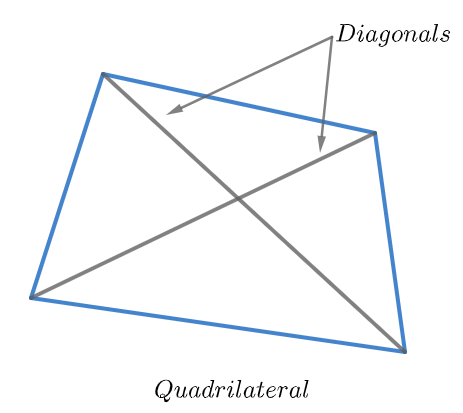
Fill in the blanks:
A quadrilateral has ____ diagonals?
Answer
511.2k+ views
Hint: For solving these problems, we need to have a clear understanding of geometry and type of figures or polygons. Along with these we should have a clear idea about the number of sides and diagonals in different polygons. Thus, we can easily identify the number of diagonals in a quadrilateral.
Complete step by step answer:
Euclid's method is the one that consists in assuming a small set of intuitively appealing axioms, and deducing many other propositions (theorems) from these. The Elements begins with plane geometry. In geometry, a polygon is a plane figure that is described by a finite number of straight-line segments connected to form a closed polygonal chain or polygonal circuit. The solid plane region, the bounding circuit, or the two together, may be called a polygon. The segments of a polygonal circuit are called its edges or sides, and the points where two edges meet are the polygon's vertices or corners. The interior of a solid polygon is sometimes called its body. An n-gon is a polygon with n sides; for example, a triangle is a three-gon with three sides and a quadrilateral is a four-gon with four sides. Thus, we can also say that a quadrilateral has four corners.
In geometry, a diagonal is a line segment joining two vertices of a polygon or polyhedron, when those vertices are not on the same edge. Informally, any sloping line is called diagonal.
Thus, in a quadrilateral, which consists of four corners, and diagonals can be drawn using the two corners which are not on the same side. This leaves us with two diagonals joining the opposite vertices. Hence, a quadrilateral has two diagonals.

Note: These kinds of problems are pretty easy to solve, but one needs to be careful otherwise small misjudgements can lead to a totally different answer. We also should keep in mind that the diagonals are lines joining corners on different sides and not on the same side itself.
Complete step by step answer:
Euclid's method is the one that consists in assuming a small set of intuitively appealing axioms, and deducing many other propositions (theorems) from these. The Elements begins with plane geometry. In geometry, a polygon is a plane figure that is described by a finite number of straight-line segments connected to form a closed polygonal chain or polygonal circuit. The solid plane region, the bounding circuit, or the two together, may be called a polygon. The segments of a polygonal circuit are called its edges or sides, and the points where two edges meet are the polygon's vertices or corners. The interior of a solid polygon is sometimes called its body. An n-gon is a polygon with n sides; for example, a triangle is a three-gon with three sides and a quadrilateral is a four-gon with four sides. Thus, we can also say that a quadrilateral has four corners.
In geometry, a diagonal is a line segment joining two vertices of a polygon or polyhedron, when those vertices are not on the same edge. Informally, any sloping line is called diagonal.
Thus, in a quadrilateral, which consists of four corners, and diagonals can be drawn using the two corners which are not on the same side. This leaves us with two diagonals joining the opposite vertices. Hence, a quadrilateral has two diagonals.

Note: These kinds of problems are pretty easy to solve, but one needs to be careful otherwise small misjudgements can lead to a totally different answer. We also should keep in mind that the diagonals are lines joining corners on different sides and not on the same side itself.
Recently Updated Pages
The number of solutions in x in 02pi for which sqrt class 12 maths CBSE

Write any two methods of preparation of phenol Give class 12 chemistry CBSE

Differentiate between action potential and resting class 12 biology CBSE

Two plane mirrors arranged at right angles to each class 12 physics CBSE

Which of the following molecules is are chiral A I class 12 chemistry CBSE

Name different types of neurons and give one function class 12 biology CBSE

Trending doubts
Fill the blanks with the suitable prepositions 1 The class 9 english CBSE

Who among the following opened first school for girls class 9 social science CBSE

What does the word meridian mean A New day B Midday class 9 social science CBSE

What is the full form of pH?

Write the 6 fundamental rights of India and explain in detail

Which places in India experience sunrise first and class 9 social science CBSE




